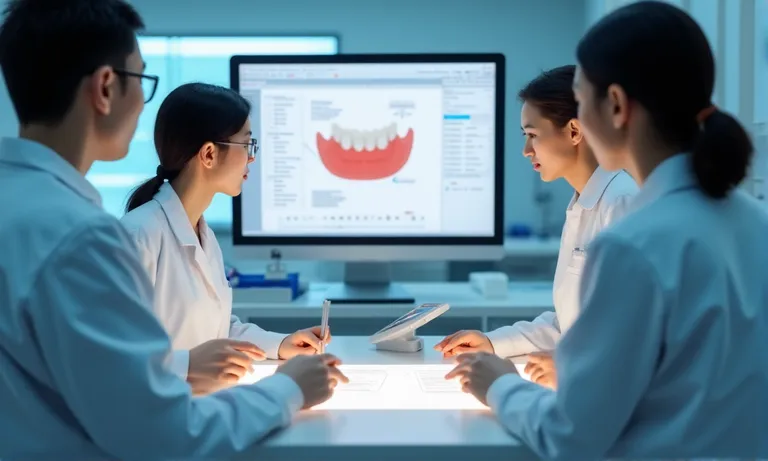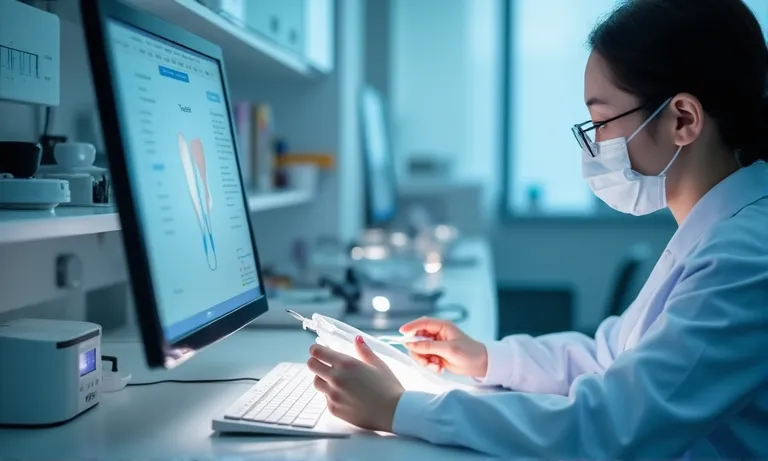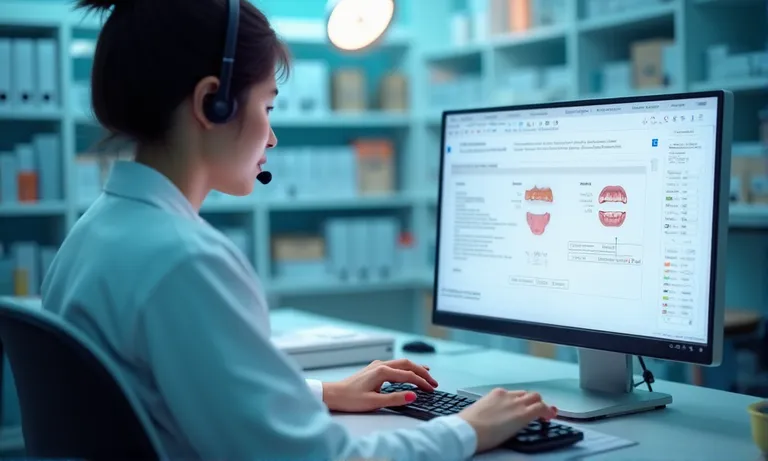Why Ask These Questions When Choosing a Tech-Enabled Lab?
Asking the right questions when selecting a tech-enabled dental lab helps uncover the lab’s actual digital maturity and alignment with your clinical or operational workflows—going beyond surface-level claims to assess future-ready capabilities.
Choosing a lab based on website claims or a list of equipment brands can lead to critical risks in long-term collaboration. Many labs highlight their adoption of CAD/CAM or 3D printing, but the real differentiator lies in how consistently and effectively these technologies are used in live workflows. For procurement teams, especially in group practices and DSOs, understanding the lab’s operational depth—not just its tech labels—directly impacts remake rates, turnaround times, and case accuracy.

dental-lab-team-reviewing-digital-workflows
What risks come with choosing a lab based only on claimed technologies?
Labs often promote digital equipment like 3D printers or intraoral scanner compatibility, but without insight into how those tools are integrated into daily production, procurement teams risk entering unstable partnerships. We’ve seen clinics frustrated by labs that had the right hardware but lacked consistent protocols, leading to remake loops or misaligned timelines. One group practice client shared that a previous lab “had great tech but couldn’t explain how it was used in crown quality checks.” That resulted in unpredictable outcomes—despite seemingly advanced infrastructure.
How do those questions uncover real digital maturity in lab operations?
Procurement teams should assess the lab’s digital maturity across multiple operational checkpoints:
- Workflow Integration: Is technology used across all departments or siloed in one unit?
- Process Consistency: Are digital steps standardized through SOPs or left to technician discretion?
- Case Traceability: Can the lab trace a digital case from scan intake through final QA digitally?
- Staff Proficiency: Are technicians trained and certified to use tech platforms effectively?
These dimensions distinguish a truly tech-enabled lab from one that’s partially digitized for marketing purposes.
Why is understanding tech-readiness critical for future-proof partnerships?
Digital maturity isn’t just a current-state indicator—it’s a predictor of a lab’s ability to scale, integrate, and adapt as your own workflows evolve. For practices considering intraoral scan adoption, multi-location expansion, or AI-assisted diagnostics, lab partners must be operationally prepared—not just aspirationally willing. Without this readiness, technical collaboration turns into troubleshooting, and trust erodes quickly.
Labs like Raytops Dental Lab have collaborated with practices transitioning to digital workflows, not by pushing new tools, but by co-building scanning protocols, integrating intake forms, and sharing QA data transparently. These are the quiet yet essential behaviors that define scalable partnerships.
Smart procurement starts with sharp questioning—because in a tech-driven environment, what you don’t ask may cost you more than what you do.
How Can You Verify a Lab’s Real-World Technology Implementation?
Choosing a tech-enabled lab requires more than reviewing a list of machines—it demands clear proof that the lab’s team, workflows, and QA processes truly rely on those tools in daily production. This ensures consistency, accuracy, and partnership readiness in real cases—not just in theory.
Labs may showcase CAD/CAM systems, 3D printers, or AI design tools, but only direct evidence of day-to-day usage confirms operational maturity. Procurement teams should look for signs that these technologies are used not just occasionally, but as standard practice embedded in the lab’s production culture.

dental-lab-technician-operating-digital-tools
Are lab technicians actively using CAD/CAM, 3D printing, and AI in live cases?
Technology must be integrated into the technician’s hands—not just in the lab’s marketing. We’ve worked with clinics that previously partnered with labs boasting AI-assisted design, only to discover it was limited to occasional test cases. In contrast, when Raytops Dental Lab was onboarded by a DSO migrating to intraoral scanning, over 85% of crown cases were designed through CAD workflows within the first month—enabled by trained staff and existing digital SOPs. This distinction isn’t about having the tools; it’s about embedding them into repeatable processes.
Does the lab maintain documented SOPs and QA processes for tech-enabled workflows?
To validate a lab’s true digital maturity, check for the following:
- Standardized digital workflows: Are CAD/CAM design steps documented across case types?
- QA checkpoints: Are there verification points tied to digital scans, margin control, or AI detection?
- Version control: Does the lab maintain structured file-naming, case log tracking, or digital case archiving?
- Issue management: Is there a documented procedure for digital case remake analysis?
Labs that rely on digital tools daily will have clear processes to match—these SOPs are not add-ons; they are the backbone of scale-ready production.
Is staff training part of their standard onboarding for new technology?
A structured path to verify a lab’s implementation readiness:
- Ask for onboarding protocols: Does the lab have internal training decks, certifications, or case walkthroughs for new hires?
- Review staff upskilling records: How often is training updated when new systems are adopted?
- Request role-specific digital SOPs: Are designers, finishers, and QA roles all trained on their part in digital workflows?
When one European clinic transitioned to digital impression capture, they faced initial frustration with their first lab—margin gaps and inconsistent contacts. The issue wasn’t scanner compatibility, but technician misinterpretation. In later onboarding with Raytops, training alignment sessions were held in advance of live cases—cutting remake rates by 12% in the first 60 days.
Labs that take digital seriously, invest seriously—in tools, people, and processes. That’s the difference between display technology and delivery technology.
What Questions Help Confirm Workflow Compatibility with Your Practice?
To avoid workflow friction and costly miscommunication, ensure your dental lab fully supports your existing scan formats, software tools, and digital submission processes. Compatibility determines how smoothly your team and the lab can collaborate without delays or conversion errors.
Digital collaboration often fails not because of technical flaws, but because of mismatched file types, platform assumptions, or disjointed case handoffs. By asking the right compatibility questions upfront, you avoid future inefficiencies that are hard to unwind once the partnership begins.

dental-digital-case-upload-portal
Do they support your scan and design formats (e.g. STL, PLY, DICOM)?
| Format Type | Importance | What to Confirm |
|---|---|---|
| STL | Standard for most IOS workflows | Does the lab accept raw and pre-aligned STL files? |
| PLY | Includes color/texture info | Is their design team trained to use color mapping for margin detection? |
| DICOM | Used in surgical and ortho planning | Can their platform process or overlay DICOM with prosthetic scans? |
Some labs claim “format compatibility” but rely on third-party conversion tools that add noise or data loss. One Australian practice we worked with had to re-export their scans multiple times due to a lab’s outdated design environment. Compatibility isn’t just about formats—it’s about native handling.
Do they operate with open systems or require specific software?
- Open labs accept a wide range of file types and design inputs, giving your team more control over scanners and software choices.
- Closed labs may lock workflows into specific tools—often requiring license fees or format restrictions.
- Hybrid setups exist, but transparency is key: Can the lab clearly explain where you’ll face conversion steps or workflow bottlenecks?
We’ve seen small clinics stuck in upgrade loops just to stay compatible with a “digital partner.” A truly collaborative lab works within your constraints, not theirs.
How is digital case intake handled—via portal, app, or manual upload?
The method for case submission often reveals the lab’s operational maturity. Some labs still rely on emailed files or unstructured uploads, increasing risk for versioning errors or incomplete documentation.
At Raytops, we onboarded a new DSO partner by mirroring their existing case naming and intake structure. Their dentists preferred a structured portal workflow with built-in prescription fields and multi-format preview. By aligning case intake systems, we reduced back-and-forth emails by 15% within the first month—and brought average approval time down from 2.4 days to 1.1 days.
Submission isn’t just about upload—it’s about alignment, efficiency, and trust.
How Can You Evaluate the Lab’s Support and Responsiveness?
Strong digital labs don’t just deliver restorations—they support them. To assess support quality, evaluate how a lab communicates during case issues, what turnaround benchmarks they maintain, and how they handle remakes or technical mismatches. A reliable partner proves their value not only when things go right, but when things go wrong.
Labs may have the right tools, but it’s their service infrastructure that determines collaboration success. Digital maturity is incomplete without consistent, transparent support.

Image
ALT: dental-lab-customer-support-chat
Prompt:
A highly realistic, ultra-detailed, professional-quality image captured in a clean, organized dental lab environment. Lighting is natural daylight. Show a customer support specialist responding to a case issue via live chat on a desktop, with digital dental files visible, headset on, and TAT tracker chart in the background.
Is there a dedicated team or channel for digital case communication?
- Named contact points: Does the lab assign a case manager or technician for recurring accounts?
- Live support availability: Can you reach the lab via portal chat, email, or phone within working hours?
- Multi-timezone support: If your practice operates outside of China time, are there overlapping hours?
We’ve seen clinics drop labs not for quality issues, but because “getting a question answered took 3 days.” A quick crown fix means little if your patient’s chair time is locked. Response time = confidence.
What is their average TAT for digital crown & bridge cases?
| Restoration Type | Standard TAT (Days) | Flag for Delay |
|---|---|---|
| Zirconia Crown | 5–7 days | >9 days repeatedly |
| E.max Veneer | 7–9 days | >10 days |
| Implant Crown | 8–10 days | >12 days |
| Remake Case | 3–5 days | >7 days |
Labs may list standard turnaround times, but only practice feedback confirms reliability. When Raytops onboarded a clinic that previously suffered from “hidden backlogs,” we started by sending weekly TAT reports and marking cases at risk of delay. This transparency helped restore client trust and reduce reactive escalations.
How do they respond when remakes or file issues arise?
When remakes happen—and they will—it’s the lab’s handling process that sets them apart. Is there a structured way to report issues? How fast do they respond? Are remake cases tracked and learned from?
A Canadian group practice shared that their prior lab “insisted errors were on our side” without reviewing the files. In contrast, during onboarding with Raytops, our team flagged an abutment mismatch pre-fabrication, suggested a rescan, and logged it into a shared issue tracker. The case was delivered 48 hours later, with clear documentation and zero blame-shifting.
Support isn’t an extra feature—it’s the infrastructure that makes digital collaboration truly functional.
What Proof Points or Evidence Should You Request?
When evaluating a tech-enabled lab, don’t just trust their sales materials—ask for documented proof that demonstrates digital maturity, successful client transitions, and consistent quality. Verifiable evidence is the bridge between claims and confidence.
Labs that deliver real value are not afraid to show their work. Whether through client references, onboarding pilots, or performance dashboards, transparency is a sign of operational control—not just marketing polish.

dental-lab-digital-case-study-dashboard
Can they provide case studies or documented success with digital transitions?
Ask for specific examples of how the lab has supported other clinics in adopting or scaling digital workflows. Did they co-develop protocols? Provide training? Track results?
One DSO client told us that their biggest concern wasn’t scanner compatibility—but how to get 12 locations aligned under a unified prescription workflow. During onboarding, Raytops provided a three-week guided pilot using templated lab slips, file checklists, and preset margin instructions. Within 60 days, 88% of new cases followed the unified protocol—cutting order variations by nearly half.
Real proof doesn’t look like a sales deck. It looks like shared process improvements.
Are there onboarding pilots, validation batches, or client references?
- Onboarding pilots: Can the lab simulate a mini-rollout to test compatibility?
- Validation batches: Will they produce sample units under your SOP to ensure alignment?
- Reference clients: Can they provide contact info or feedback from similar-sized practices?
This level of openness signals both operational readiness and cultural fit for collaboration. If a lab avoids pilots or references, it’s worth asking: why?
Do they share QA results like remake rates or production consistency?
| Metric | Why It Matters | What to Look For |
|---|---|---|
| Remake Rate (%) | Indicates quality and communication alignment | <3% is best-in-class |
| TAT Consistency | Predictability of delivery | >85% cases on-time |
| Adjustment Feedback | Captures chairside refinement needs | Data gathered + acted upon |
| First-pass Accuracy | Reduces wasted time | >90% without correction |
Labs like Raytops maintain weekly internal reports across these dimensions, and we share summary dashboards during quarterly reviews with long-term clients. These data points allow clients to move from “hoping” to “knowing” their supplier is consistent.
Numbers build trust—especially when things are going well.
Should You Tailor Questions Based on Practice Type or Scale?
Yes—your lab evaluation questions should reflect the specific needs, risks, and operational patterns of your practice size and model. A one-size-fits-all approach overlooks critical compatibility factors.
A solo practitioner may care most about file compatibility and turnaround time, while a DSO might prioritize SOP alignment, bulk validation, and cross-location consistency. Similarly, distributors often need to verify lab training capacity and product standardization before committing to scale.

dental-practice-size-vs-lab-requirements
Do group practices or DSOs require different validation expectations?
Larger group practices often work across multiple locations, which means decentralized scan sources, varying clinician preferences, and strict internal QA benchmarks. They typically require:
- Structured onboarding pilots to align protocols across sites
- Centralized dashboards for tracking TAT, remake rates, and approval timelines
- Role-specific SOPs for front-desk staff, dentists, and treatment coordinators
When onboarding a 10-location DSO, Raytops provided version-controlled PDF guides for case intake, file naming conventions, and integrated feedback loops with each regional lead. This allowed local autonomy without sacrificing cross-site consistency.
Questions should reflect this complexity: “How do you ensure consistency across multiple clinics?” is far more useful than “Do you do crowns well?”
Should smaller clinics adjust based on volume or use simple pilot programs?
- Start small: Ask for a micro-pilot—3–5 test units with feedback built-in
- Request feedback loops: Ensure each case has a debrief to capture mismatch or friction
- Prioritize communication cadence: Confirm how fast you can expect answers, especially in different time zones
- Gauge empathy, not just expertise: A good lab for smaller clinics understands the learning curve and can provide advisory support
We’ve helped many first-time digital clinics bridge the gap by aligning scanner settings, redesigning prescription templates, and walking them through intraoral scan validations—without pressure to scale too fast.
Should channel partners or distributors evaluate lab SOPs and training mechanisms?
Distributors and channel partners rely on consistency—they are not just buying a crown; they’re committing to a product line. For this group, lab vetting should include:
- Factory-level SOP documentation
- Batch-level traceability for product consistency
- Technician training records and certification programs
- Scalability protocols for fluctuating order volumes
A German distributor we partnered with asked not about “price per unit,” but how we trained new hires to maintain the same finish quality. The answer? A four-week rotational program across design, milling, and QC, standardized in three languages.
When scale is your business model, repeatability is your survival strategy.
Conclusion
Choosing a tech-enabled dental lab isn’t about checking off equipment lists—it’s about evaluating how that lab collaborates, adapts, and delivers value in real-world conditions. The right questions help you look past marketing claims and understand a lab’s digital maturity, operational reliability, and partnership readiness.
As an overseas dental lab, we’ve supported practices of all sizes in aligning workflows, reducing remake risks, and scaling digital adoption with clarity and consistency. Whether you’re running a single-chair clinic or managing a multi-site DSO, asking the right questions leads to the right collaboration.


